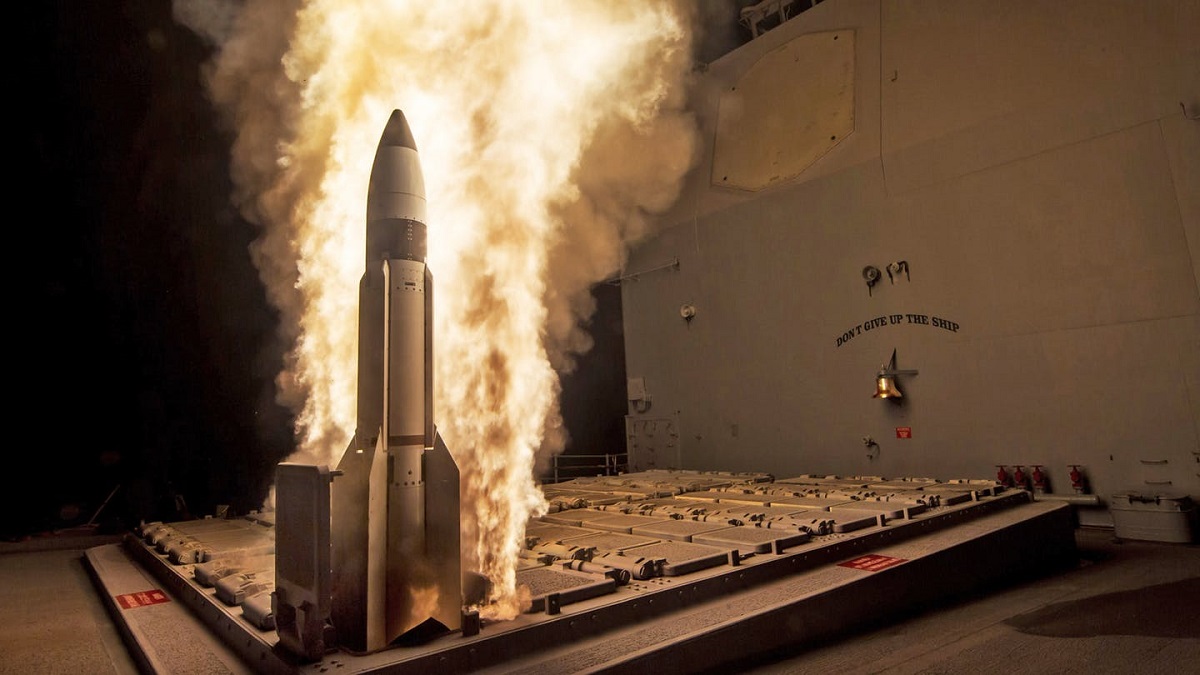To fortify its defense capabilities against the persistent threats posed by North Korea and China, South Korea has announced plans to purchase Standard Missile-3 (SM-3) shipborne interceptors from the United States.
US CH-53K King Stallion Packs A Punch – Gets Refueled Mid-Air While Carrying F-35C Stealth Fighter
The decision, disclosed by the state procurement agency on April 26, marks a crucial step in enhancing the country’s defense posture in the face of evolving regional security challenges.
The Defense Acquisition Program Administration (DAPA) confirmed that its weapons program review committee has approved the procurement program.
According to the agency, South Korea intends to acquire the SM-3 interceptors through government-to-government foreign military sales by 2030, with an estimated cost of 803.9 billion won (approximately US$583.4 million).
The SM-3, a ship-based surface-to-air missile system utilized by the US Navy, is known for its capability to intercept incoming ballistic missiles at altitudes exceeding 100 kilometers.
Once acquired, these interceptors are expected to be integrated into the South Korean Navy’s new Aegis destroyers, bolstering their anti-ballistic missile capabilities.
Currently, South Korea deploys SM-2 ship-to-air missiles on its existing fleet of Aegis destroyers to counter North Korean missile threats. However, the acquisition of SM-3 interceptors represents a strategic shift towards more advanced and longer-range defense systems.
In addition to procuring SM-3 interceptors, South Korea is also looking to acquire Standard Missile-6 (SM-6) shipborne missiles.
Last year, the US Department of State approved a potential sale of SM-6 interceptors and related equipment to enhance South Korea’s security. The South Korean government aims to purchase up to 38 SM-6 Block I missiles, vertical launch system canisters, and training aids.
Meanwhile, the SM-3 interceptors are expected to be outfitted onto the new KDX-III Batch II Aegis destroyer, named Sejong the Great.
As part of the Korea Air and Missile Defense (KAMD) strategy, the ‘Sejong the Great-class’ class Aegis destroyers will be crucial in enhancing South Korea’s ballistic missile defense capabilities.
These destroyers, equipped with the latest Aegis combat system, Baseline 9.C2 ‘KII,’ offer improved detection performance and compatibility with Raytheon Technologies Corporation’s (RTX) SM-6 and SM-3 missiles.
The lead ship of the KDX-III Batch II program, ROKS Sejong the Great-class, began sea trials in October 2023 and is scheduled for delivery to the Republic of Korea Navy in November 2024.
SM-3 Deployment To Deter North Korea & China
The SM-3, known for its exo-atmospheric capabilities, is a vital component of the Aegis Weapon System, utilizing hit-to-kill kinetic kill vehicles to intercept ballistic missiles during the midcourse phase of their flight path.
Initially intended to complement the lower-tier SM-2 Block IVA, plans for the SM-3 were altered when the latter was scrapped in December 2001.

However, advancements in Aegis software have enabled the SM-3 to collaborate effectively with both lower-tier SM-2 and SM-6 air defense missiles.
Meanwhile, South Korea’s decision to acquire SM-3 interceptors follows a comprehensive study conducted by the Korea National Defense College in March 2017, commissioned by the Ministry of Defense.
The study emphasized the efficacy of sea-launched anti-ballistic missiles, particularly SM-3, in countering high-angle, high-altitude North Korean nuclear missile launches and electromagnetic pulse (EMP) threats.
Similarly, the Chairman of the ruling People’s Party’s Special Committee on North Korean Nuclear Crisis Response, Retired General Kiho Han, previously stressed enhancing South Korea’s missile defense capabilities.
He noted the need for a robust triad system to defend against missile threats. He noted the importance of acquiring SM-3 interceptors to ensure the credibility of South Korea’s missile defense system.
Notably, the introduction of SM-3 missiles is seen as crucial not only for countering North Korean threats but also for addressing broader regional security challenges.
The threats from a “resurgent Russia and a rising China,” along with China’s rapid naval expansion, have also underscored the urgent requirement for modern warships equipped with powerful anti-ballistic missile systems.
In addition to anti-ballistic missile capabilities, the deployment of SM-3 missiles presents an opportunity for South Korea, the USA, and Japan to ensure the incapacitation of Chinese satellites if necessary.
Moreover, the recent debut of the SM-3 missile in intercepting ballistic missiles during the US response to the Iranian attack on Israel highlights its effectiveness and versatility.
Japan, too, operates SM-3 missiles aboard its Aegis destroyer fleet and plans to integrate them into its upgraded Aegis system-equipped ships. On the flip side, China consistently condemns the deployment of such missiles as a menace to their nuclear deterrence capabilities, thereby posing a threat to strategic stability.
- Contact the author at ashishmichel(at)gmail.com
- Follow EurAsian Times on Google News




